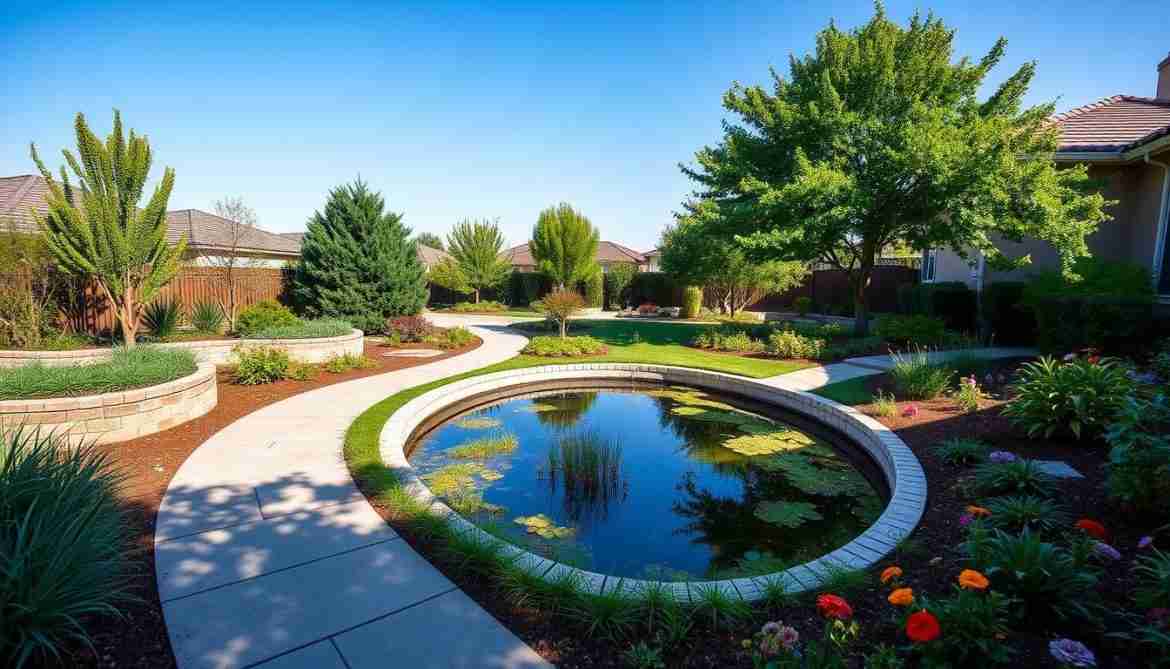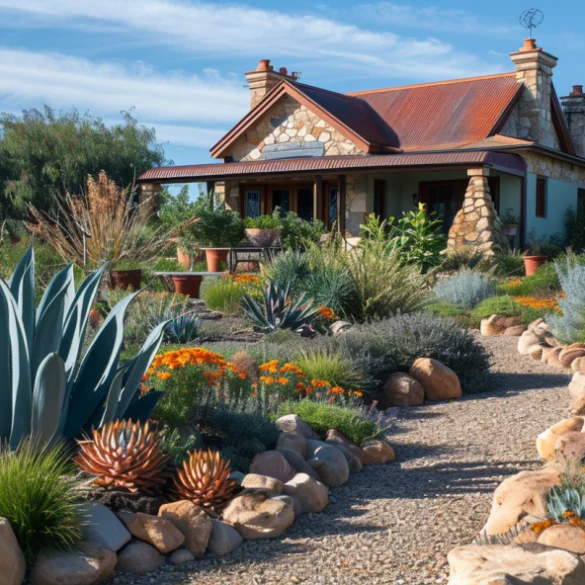Just one inch of water can cause over $25,000 in damage to a home1. Flooding has gone up by 25% in some places over the last ten years2. It’s important to focus on flood-resistant landscaping and sustainable site design to reduce flood risks. Every area, from Queensland’s cities to Victoria’s hills, needs a special plan to fight flooding3.
A landscape that slopes away from your house is key. It should slope at least 5% to help water flow away1. Australians are using smart landscaping to protect their homes from floods.
Key Takeaways
- Use flood-resistant materials to cut repair costs by up to 40%2.
- Keep sump pumps working well to cut basement flooding in half2.
- Make sure your home’s slope is at least 5% to fight water pooling1.
- Clean gutters and downspouts to lower water damage risk by 15%2.
- Get ready for floods to recover faster by 20%2.
- Choose plants that do well in both wet and dry conditions1.
Understanding the Impact of Flooding on Your Landscaping
Flooding can harm your property’s landscape. Using sustainable landscaping practices is key. Good landscaping and flood strategies keep your land looking good and strong against floods.
Water management landscaping is vital. It helps keep water away from your home. This protects your space from water damage4.
The Role of Effective Landscaping in Flood Mitigation
Using plants with deep roots can stop erosion and control water flow4. Retaining walls also help manage water. They make your land better at handling water, keeping it safe from floods4.
Long-Term Planning for Protecting Your Property Against Flooding
Long-term planning is key to fighting flood risks. Regular maintenance and seasonal checks keep your landscape stable5. It’s wise to talk to experts for big projects like grading and site design4.
Guarding Your Garden Beds: Strategic Planting for Water Management
Native shrubs and trees help absorb water and prevent floods4. Mulches and the right planting methods also help. They keep water away from your home’s foundation and guide it to drainage areas.
Landscaping not only makes your property look better but also protects it from disasters. For more on eco-friendly materials, check out Sustainable Home Magazine’s guide on green building materials5.
| Strategy | Benefits | Implementation Consideration |
|---|---|---|
| Utilizing native plants | Improves water absorption, reduces erosion | Choose plants adapted to local climate and soil conditions. |
| Strategic placement of mulches | Helps in water retention and prevents soil erosion | Use organic mulches like wood chips or straw. |
| Installation of retaining walls | Manages water flow, creates barriers against floodwaters | Assess the landscape’s slope; consider materials like stone or concrete. |
Assessing Flood Risk and Site Vulnerability
Homeowners in flood-prone areas need a comprehensive flood risk assessment for landscaping. This starts with knowing the annual exceedance probability (AEP). It shows how likely a flood of a certain size is each year6. Adding green infrastructure for flood control helps lower this risk. It also makes your property stronger against floods.

The NSW Flood Prone Land Policy uses a merit-based system for flood risk plans. This approach helps communities and property owners a lot7. Knowing your site’s weak spots is key. Things like the land’s shape, slope, and drainage systems matter a lot. Experts say a slope of 0.6 inches per foot away from buildings helps move floodwater7.
| Flood Impact | Average Annual Damage Evaluation | Personal Property Risk |
|---|---|---|
| AEP/Year | Economic Assessment | Vulnerability Level |
| Significant6 | Considerable6 | High6 |
Using flood barriers or French drains can protect your property from floods. These solutions are made to fit your landscape. They use data on your land and flood patterns to design them76.
Also, keep up with local flood plans and insurance. These are key for a good flood risk assessment for landscaping. The Victorian Floodplain Management Strategy helps understand flood risks. It’s useful for making flood protection plans for your home6.
Strategies for Sustainable Flood Mitigation through Site Design
Using sustainable flood mitigation strategies in cities is now key due to climate changes. Australia’s extreme weather events are expected to increase. So, we must improve how we manage water in cities8. This means using green infrastructure solutions and stormwater management strategies to reduce risks and protect the environment.
Improving Soil Drainage and Reducing Surface Runoff
Improving soil drainage helps manage runoff well. Sustainable drainage systems capture and slowly release rainwater. This reduces flooding and keeps natural water cycles9. Rain gardens and bio-swales are good choices because they look nice and help absorb rain8.
Utilizing Permeable Materials for Pavements and Driveways
Choosing the right materials for city infrastructure is important for flood control. Using materials like gravel or pervious concrete in pavements and driveways cuts down runoff. It also helps keep water during rain8. This supports using eco-friendly materials in city planning9.
Eco-Friendly Flood Control Measures: From Rain Barrels to Bio-Swales
Rain barrels can greatly help manage stormwater by reducing runoff and saving rainwater for plants8. Wetlands and bio-swales with flood-tolerant plants also lower flood risk. They help the environment and fight climate change8. China’s sponge cities aim to use a lot of rainwater by 2030, showing a big commitment to green cities8.
To learn more about these ideas, check out air-purifying plants. They improve indoor air and health, fitting with green home goals.

| Flood Mitigation Strategy | Benefits |
|---|---|
| Rain Gardens | Reduces runoff, enhances water quality, adds aesthetic value to urban spaces |
| Permeable Pavements | Allows water to seep through, reducing runoff and recharging groundwater |
| Bio-Swales | Filters pollutants from runoff, facilitates water absorption, promotes biodiversity |
| Rain Barrels | Collects rainwater for reuse, eases strain on urban drainage systems |
Using these green infrastructure solutions makes cities better at handling stormwater. It turns cities into strong, green places ready for climate change89.
Choosing Flood-Resilient Plants and Implementing Water-Tolerant Gardens
Climate change is making weather worse, so picking flood-tolerant plant selection is key. Over the last 30 years, severe rain has gone up a lot10. Your garden needs to be tough and green to handle this.
Rain gardens are great for looks and fighting floods. They cut pollution in creeks and streams by 30%10. They also protect your home from flood damage with the right plants10.
Using native plants and special designs like stormwater tree trenches helps a lot. These methods cut down runoff and help the ground soak up water11. Plants in these designs also catch rain all year, helping the environment and keeping air clean12.
Here’s a guide for picking plants for a flood-safe garden:
- Trees: Choose cypress, willow, and oak for their water love.
- Grasses: Sedges and rushes are perfect for wet spots.
- Ornamental plants: Dogwood, azaleas, and irises are pretty and help the soil and water.
Adding green and blue roofs in cities also helps a lot. They cut down flood and runoff, making your place safer and more valuable11.
| Feature | Water Absorption Capacity | Added Benefits |
|---|---|---|
| Green Roofs | High | Reduces temperatures and noise |
| Rain Gardens | Moderate to High | Increases biodiversity, adds aesthetic appeal |
| Permeable Pavement | High | Reduces annual runoff volumes by approximately 60%11 |
These features make your landscape strong against floods. They also help make a green, safe place for all. Think about these ideas for your flood-prone landscape design. They protect your home and help the planet.
Landscaping and Site Planning for Flood Mitigation
As homeowners, your landscaping and site planning are key to fighting flooding. By using flood-resistant landscaping and site grading, you can lessen flood damage. Also, smart stormwater management solutions help a lot.
Adding raised green spaces like raised plant beds is both pretty and practical. They keep water away from your home’s base. This, along with site grading for flood protection, protects your home from water harm13.
Site Grading for Flood Protection: Ensuring Proper Slope and Drainage
Good site grading keeps water away from your home. Mixing topsoil and sand in low spots helps with drainage. This method also makes your garden healthier13.
Stormwater Management Techniques: Rain Gardens and Terracing
Using rain gardens and terracing helps your garden and the environment. Rain gardens soak up water, feeding plants. Terracing slows water flow, preventing erosion. These methods are good for your garden and look nice13.
These methods improve your property’s value and help manage stormwater. Making your landscape flood-resistant is smart. It keeps your investment safe and supports green living13.
Learning and using these methods now can protect and increase your property’s value. For more on flood-resistant gardening and site planning, check out Sustainable Home Magazine at https://sustainablehomemag.com.
Final Thoughts
Protecting your property from flooding is key. Eco-friendly flood control measures help a lot. They not only reduce damage but also show you care about the planet.
Floods are a big problem, causing 43% of natural disasters from 1995 to 2015. They affect over half of people hit by disasters14. We need to make our land more flood-resistant. Rain gardens are a great example, helping both people and nature8.
Water-tolerant gardens and flood-resistant designs can help a lot. Since 1990, over 2.8 billion people have been affected by floods14. Working together, we can make our homes safer and more eco-friendly.
By choosing eco-friendly options, you’re part of a bigger movement. Leaky barriers and wetland restoration help protect us and nature8. Sustainable Home Magazine and others show us the way. We can find a balance where safety and nature thrive together ecologically.







